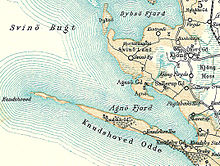Long dolmen in Oreby Skov
The Langdolmen in Oreby Skov ( Danish Langdysse i Oreby Skov ) is north of the road through the Oreby forest and west of two burial mounds from the Bronze Age .
The forest is at the beginning of the Knudshoved Odde peninsula on the Danish island of Zealand . In Oreby Skov there are seven protected monuments from the Neolithic and Bronze Age, including a passage grave and the long dolmen . It was placed under protection in 1878 but was still further destroyed. Neither finds nor other information are known. The megalithic systems of the funnel beaker culture (TBK) originated between 3500 and 2800 BC. Chr.
description
The long barren bed is oriented north-south. In the middle of the almost completely excavated hill is the east-west oriented chamber of a polygonal pole made of five bearing stones and a large capstone ( in situ ), a large part of which is blasted off and lies to the west of the chamber. Access to the chamber, which was completely enclosed by the hill, is through a narrow passage to the east.
Seen from the outside, the barren bed in the Oreby Forest was originally a rectangular, stone-enclosed hill about two meters high. The 27 remaining curbs of the hillside are still visible, but most of them have overturned. In the north and south there were large guard stones, also known as "Steven stones". The forest is a habitat for rare orchids and the beetle Osmoderma eremita .
See also
literature
- Karsten Kjer Michaelson: Fortidsminder på Fyn - fantasiens trædesten . Odense 2003, ISBN 87-7838-853-8 , pp. 87 .
Individual evidence
- ↑ Langdysse is the Danish name for dolmens that lie in a rectangular or trapezoidal barn, in contrast to the Runddysser, those dolmens that lie in a round hill
Web links
Coordinates: 54 ° 56 '38.9 " N , 12 ° 12' 10.1" E
